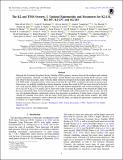| dc.contributor.author | Huang, Chelsea X. | |
| dc.contributor.author | Ricker, George R | |
| dc.contributor.author | Seager, Sara | |
| dc.contributor.author | Vanderspek, Roland K | |
| dc.contributor.author | Daylan, Tansu | |
| dc.contributor.author | Günther, Maximilian N. | |
| dc.date.accessioned | 2022-08-23T20:30:51Z | |
| dc.date.available | 2021-10-27T20:04:27Z | |
| dc.date.available | 2022-01-20T15:31:08Z | |
| dc.date.available | 2022-08-23T20:30:51Z | |
| dc.date.issued | 2020-10 | |
| dc.date.submitted | 2020-07 | |
| dc.identifier.issn | 1538-3881 | |
| dc.identifier.uri | https://hdl.handle.net/1721.1/134325.3 | |
| dc.description.abstract | © 2020. The American Astronomical Society. All rights reserved. Although the Transiting Exoplanet Survey Satellite (TESS) primary mission observed the northern and southern ecliptic hemispheres, generally avoiding the ecliptic, and the Kepler space telescope during the K2 mission could only observe near the ecliptic, many of the K2 fields extend far enough from the ecliptic plane that sections overlap with TESS fields. Using photometric observations from both K2 and TESS, combined with archival spectroscopic observations, we globally modeled four known planetary systems discovered by K2 that were observed in the first year of the primary TESS mission. Specifically, we provide updated ephemerides and system parameters for K2-114 b, K2-167 b, K2-237 b, and K2-261 b. These were some of the first K2 planets to be observed by TESS in the first year and include three Jovian sized planets and a sub-Neptune with orbital periods less than 12 days. In each case, the updated ephemeris significantly reduces the uncertainty in prediction of future times of transit, which is valuable for planning observations with the James Webb Space Telescope and other future facilities. The TESS extended mission is expected to observe about half of the K2 fields, providing the opportunity to perform this type of analysis on a larger number of systems. | en_US |
| dc.language.iso | en | |
| dc.publisher | American Astronomical Society | en_US |
| dc.relation.isversionof | http://dx.doi.org/10.3847/1538-3881/ABA964 | en_US |
| dc.rights | Article is made available in accordance with the publisher's policy and may be subject to US copyright law. Please refer to the publisher's site for terms of use. | en_US |
| dc.source | The American Astronomical Society | en_US |
| dc.title | The K2 and TESS Synergy. I. Updated Ephemerides and Parameters for K2-114, K2-167, K2-237, and K2-261 | en_US |
| dc.type | Article | en_US |
| dc.contributor.department | Massachusetts Institute of Technology. Department of Physics | en_US |
| dc.contributor.department | MIT Kavli Institute for Astrophysics and Space Research | en_US |
| dc.contributor.department | Massachusetts Institute of Technology. Department of Earth, Atmospheric, and Planetary Sciences | en_US |
| dc.contributor.department | Massachusetts Institute of Technology. Department of Aeronautics and Astronautics | en_US |
| dc.relation.journal | Astronomical Journal | en_US |
| dc.eprint.version | Final published version | en_US |
| dc.type.uri | http://purl.org/eprint/type/JournalArticle | en_US |
| eprint.status | http://purl.org/eprint/status/PeerReviewed | en_US |
| dc.date.updated | 2021-09-30T11:45:42Z | |
| dspace.orderedauthors | Ikwut-Ukwa, M; Rodriguez, JE; Bieryla, A; Vanderburg, A; Mocnik, T; Kane, SR; Quinn, SN; Colón, KD; Zhou, G; Eastman, JD; Huang, CX; Latham, DW; Dotson, J; Jenkins, JM; Ricker, GR; Seager, S; Vanderspek, RK; Winn, JN; Barclay, T; Barentsen, G; Berta-Thompson, Z; Charbonneau, D; Dragomir, D; Daylan, T; Günther, MN; Hedges, C; Henze, CE; McDermott, S; Schlieder, JE; Quintana, EV; Smith, JC; Twicken, JD; Yahalomi, DA | en_US |
| dspace.date.submission | 2021-09-30T11:45:43Z | |
| mit.journal.volume | 160 | en_US |
| mit.journal.issue | 5 | en_US |
| mit.license | PUBLISHER_POLICY | |
| mit.metadata.status | Ready for Final Review | en_US |
